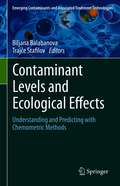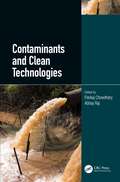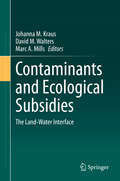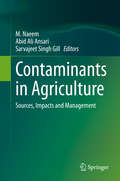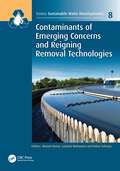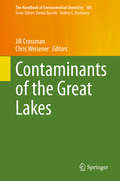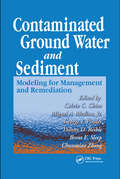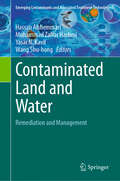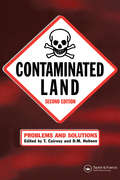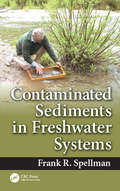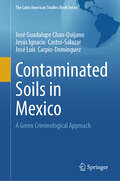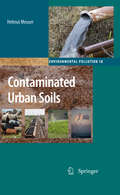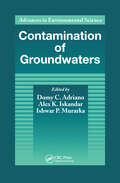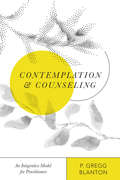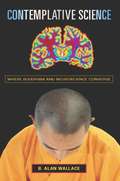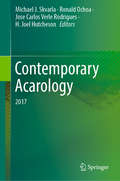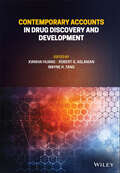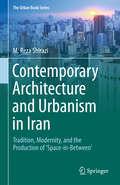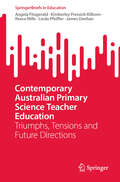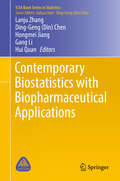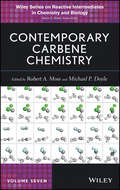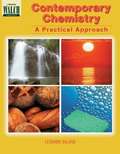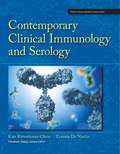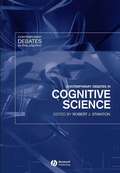- Table View
- List View
Contaminant Levels and Ecological Effects: Understanding and Predicting with Chemometric Methods (Emerging Contaminants and Associated Treatment Technologies)
by Biljana Balabanova Trajče StafilovThis volume uses chemometric mathematical modelling approaches to investigate geographic areas at risk of ecological degradation due to pollution. While most analytical approaches in environmental research involve sophisticated and sensitive instrumental techniques, this book employs chemometric techniques to create a corresponding data matrix to extract accurate and realistic environmental information in areas vulnerable to and affected by hazardous substances. The text offers case studies to establish a general framework of the opportunities, advantages, weaknesses and challenges of these mathematical approaches, and provides a chemometric model of each focus area to assess the long-distance distribution of pollutants. The case studies highlight the potential use of novel chemometric models for mitigating and preventing environmental pollution and ecological risks, while also providing reviews of the current status and developments in chemometric analysis of environmental pollution. The book will be of interest to students and researchers in environmental and agricultural chemistry, environmental pollution modelling and ecological degradation.
Contaminants and Clean Technologies
by Pankaj Chowdhary Abhay RajContaminants and Clean Technologies provides valuable information on environmental contaminants such as industrial pollutants, micropollutants, pesticides, endocrine disruptors, pharmaceuticals, toxins, and hormones. It focuses on the various types of environmental contaminants discharged from various sources; their toxicological effects in environments, humans, animals, and plants; and their removal methods. It also covers, comprehensively, information on the contaminants released by various industries and agricultural practices, which cause severe threats to the environment. Features of the book: Elucidates systematic information on various types of environmental contaminants, and their fate and consequences Discusses contaminants such as endocrine disruptors, pharmaceutical waste, and personal care products Provides an overview of physicochemical and biological treatment technologies for sustainable development Details recent research finding in the area of environmental contaminants and their future challenges
Contaminants and Ecological Subsidies: The Land-Water Interface
by Johanna M. Kraus David M. Walters Marc A. MillsThis volume explores the effects of aquatic contaminants on ecological subsidies and food web exposure at the boundary of aquatic and terrestrial ecosystems. It provides the first synthesis of the findings and principles governing the “dark side” of contaminant effects on ecological subsidies. Furthermore, the volume provides extensive coverage of the tools being developed to help managers and researchers better understand the implications of contaminants movement and their effects on natural resources and ecosystem processes. Aquatic and terrestrial ecosystems are linked through movements of energy and nutrients which subsidize recipient food webs. As a result, contaminants that concentrate in aquatic systems because of the effects of gravity on water and organic matter have the potential to impact both aquatic and terrestrial ecosystem processes. Within the last decade, increased attention has been paid to this phenomenon, particularly the effects of aquatic contaminants on resource and contaminant export to terrestrial consumers, and the potential implications for management. This volume, curated and edited by three field leaders, incorporates empirical results, management applications and theoretical synthesis and is a key reference for academics, government researchers and consultants.
Contaminants in Agriculture: Sources, Impacts and Management
by Sarvajeet Singh Gill M. Naeem Abid Ali AnsariThis comprehensive volume covers recent studies into agricultural problems caused by soil and water contamination. Considering the importance of agricultural crops to human health, the editors have focused on chapters detailing the negative impact of heavy metals, excessive chemical fertilizer use, nutrients, pesticides, herbicides, insecticides, agricultural wastes and toxic pollutants, among others, on agricultural soil and crops. In addition, the chapters offer solutions to these negative impacts through various scientific approaches, including using biotechnology, nanotechnology, nutrient management strategies, biofertilizers, as well as potent PGRs and elicitors. This book serves as a key source of information on scientific and engineered approaches and challenges for the bioremediation of agricultural contamination worldwide. This book should be helpful for research students, teachers, agriculturalists, agronomists, botanists, and plant growers, as well as in the fields of agriculture, agronomy, plant science, plant biology, and biotechnology, among others. It serves as an excellent reference on the current research and future directions of contaminants in agriculture from laboratory research to field application.
Contaminants of Emerging Concerns and Reigning Removal Technologies (Sustainable Water Developments - Resources, Management, Treatment, Efficiency and Reuse #8)
by Manish KumarWith an increased demand for wastewater reuse, groundwater recharge with treated wastewater has been practiced across the globe. As a result, groundwater quality deteriorates by emerging micropollutants from various anthropogenic origins, including untreated wastewater, seepage of landfill leachate, and runoff from agricultural lands. The fate of such emerging and geogenic contaminants in subsurface systems, especially in the groundwater, depends on several factors. Physicochemical properties of contaminants such as octanol-water partition coefficient, dissociation constant, water solubility, susceptibility to biodegradation under anaerobic conditions, and environmental persistence under diverse geological and pH conditions play a critical role during subsurface mass flow. Thus, advanced wastewater treatment techniques, followed by implementing stricter guidelines, are some of the measures that can safeguard water resources. This book, in general, gives an understanding of the fate and mitigation strategies for emerging and geogenic contaminants in the groundwater. The first and second sections provide a detailed insight into various removal techniques and mitigation approaches. Possible treatment strategies, including bioremediation and natural attenuation, are also covered in those sections. Environmental assessment, groundwater vulnerability, health effects, and regulations pertaining to various contaminants are systematically presented in the third section.
Contaminants of the Great Lakes (The Handbook of Environmental Chemistry #101)
by Jill Crossman Chris WeisenerThis book reviews the globally important freshwater resource of the Great Lakes, which is currently threatened by contaminants that compromise water quality and impact its ecological and economic health. Divided into four parts, this volume covers historic, current and emerging sources of contamination from heavy metals and persistent organic pollutants to microplastics; and identifies their ecological impacts. Due to factors ranging from rapidly changing land use practices, climate change and our emerging understanding of their impact on biological, chemical and physical interactions, the effectiveness of management strategies has proven highly variable. Continued enhancements in the rate of lake recovery are required to sustain the health of the Great Lakes. Accordingly, the book also explores recent advances in contaminant detection, along with future steps forward in lake management approaches. Revealing our current knowledge gaps and providing a roadmap towards sustainable solutions, the book offers a valuable asset for scientists, managers and the public alike.
Contaminated Ground Water and Sediment: Modeling for Management and Remediation
by Danny D. Reible George F. Pinder Calvin C. Chien Miguel A. Medina Brent E. Sleep Chunmiao ZhengThis book is the documented result of an expert workshop, Modeling and Management of Emerging Environmental Issues, held at Penn State University. This event assembled four panels of modeling experts from the U.S. and Canada to discuss modeling technology development and application in order to promote sound and cost-effective environmental decision-making. This thorough analysis provides an overview on the state-of-the-art in current practice and identifies emerging research and development trends within modeling technology. Each of the discussions considers not only technical issues, but regulatory and cost factors as well.
Contaminated Land and Water: Remediation and Management (Emerging Contaminants and Associated Treatment Technologies)
by Muhammad Zaffar Hashmi Hassan Alshemmari Yasar N. Kavil Wang Shu-HongThis edited volumes contains overviews and case studies of land and water contamination and remediation from international scholars, most from developing countries. Contaminated land contains substances that are actually or potentially hazardous to health or the environment. Areas with a long history of industrial production are known as brownfield land. Land contamination can result from a variety of intended, accidental, or naturally occurring activities and events such as manufacturing, mineral extraction, abandonment of mines, national defense activities, waste disposal, accidental spills, illegal dumping, leaking underground storage tanks, hurricanes, floods, pesticide use, and fertilizer application. Chemical contamination of land has degraded this important ecosystem quality. This book provides our current understanding of land pollution and water pollution in areas such as estuaries. Topics presented include major types of pollutants in contaminated land ecosystem; factors affecting the fate of pollutants in contaminated land; biomonitoring approaches to assess the contaminated land health, and chemicals impact on human health, land microbial diversity and climate change. The book further explores persistent organic pollutants, arsenic and heavy metals pollution of contaminated land and their impact on rice quality. The last chapters focus on the sustainable management and treatment of contaminated land and water.
Contaminated Land: Problems and Solutions, Second Edition
by Griselda PollockContaminated land is a problem both in the short and long term as it cannot be used without remediation. The investigation and analysis of the problem, along with the legal responsibilities surrounding the issues, continue to present difficulties to those wishing to use or develop a contaminated site. Since publication of the 1st edition, the area
Contaminated Sediments in Freshwater Systems
by Frank R. SpellmanAssessment of freshwater sediments can determine whether chemical concentrations are sufficient to cause adverse effects on aquatic organisms or organisms higher in the food chain, including humans. This book presents methods for assessing sediments and includes an integration of physical, chemical, and biological information. It examines the elements of quality assurance and control programs, considerations for the conduct of field surveys, screening-level analyses, chemical analyses, toxicity tests for assessing biological impacts, assessments of benthic invertebrate community structure, surveys of fish tumors and abnormalities, and data presentation and interpretation techniques.
Contaminated Soils in Mexico: A Green Criminological Approach (The Latin American Studies Book Series)
by José Guadalupe Chan-Quijano Jesús Ignacio Castro-Salazar José Luis Carpio-DomínguezThis book uses a green criminology lens to analyze strategies to minimize and propose alternatives on the damage caused to humans and environmental health by contaminated soils in Mexico, by recognizing that the effective application of laws is crucial for the conservation of soils. In this sense, from the perspective of contaminated soils, the compilation of data and experiences of the growing concern about the degradation of soils contaminated with hydrocarbons, heavy metals, pesticides and emerging contaminants (organic compounds, hormones and microplastics) is presented. In addition, from environmental history, the authors provide an understanding of the ontological, epistemological and methodological possibilities when assessing the relationship between the natural environment and green criminology. It is explained how the green cultural behavior of communities is directed in the face of soil contamination and environmental liabilities from the experiences of the subjects with respect to questioning the interaction of ethics and environmental responsibility. Data is presented on the consequences of soil contamination on the loss of biodiversity and the intake and bioaccumulation of pollutants in living beings. Finally, the authors discuss the deficiencies related to inspection and surveillance on issues of soil contamination, along with institutional proposals for remediation. The book seeks to position these types of issues, still scarcely discussed in Mexico, for researchers, academics, postgraduate students, decision makers and companies dedicated to the remediation and restoration of contaminated soils through sustainable management and recovery plans.
Contaminated Urban Soils (Environmental Pollution #18)
by Helmut MeuserThis book gives a current overview of all facets of urban soils. Different urban land-use types in a number of examples worldwide are introduced. Many examples in different countries are provided in order to illustrate the situation in detail. The contaminant sources of urban soils (e.g., dust deposition, contamination along roadsides, contamination of floodplains, application of wastewater, anthropogenic deposits) are comprehensively presented. For practical application purposes a key with which to identify technogenic materials during field work is presented. Features like reductomorphic conditions in landfill soils, acidification of coal mining heaps and the impact of physical characteristics such as sealing are taken into consideration in the context of the contamination problem. The mobility of contaminants in the soils under consideration is introduced and discussed. The content of the book, however, is not limited to the description of contaminated urban soils. Different methods of assessment (classification, functional assessment, assessment focused on pathways with reference to standardized exposure scenarios) are introduced. Finally, quality standards for contaminated land in a number of countries are listed, compared and discussed. The book links up the contamination problem of urban soils with geographical aspects such as the historical development of city growth, the process of urbanization and the urban-to-rural gradients. Accordingly, the reader will be able to understand the specific problems of contaminated urban soils and will find sensible approaches to assessment.
Contamination of Groundwaters
by Domy C. AdrianoInternational experts have contributed key chapters to this major work on groundwater contamination. Section 1: Methodology and Modeling deals with both organic and inorganic contaminants, including those from agricultural operations. Section 2: Case Studies presents contamination scenarios with both inorganic and organic chemicals including agriculturally-related constituents, such as the nitrates.This important new publication is a welcome addition to the literature and will enhance recent information on methodology, modeling and real-world situations. It is of interest to scientists and planners in local and national government; environmental chemists, geochemists, geologists, and health and safety officers; river authorities; hydrologists; and the mining and land reclamation industries.
Contemplation and Counseling: An Integrative Model for Practitioners (Christian Association for Psychological Studies Books)
by P. Gregg BlantonInterest in mindfulness and contemplative thought is growing among Christians, and it's time to consider the place of contemplative prayer within the field of counseling. Can contemplative prayer be integrated into therapeutic work? Can it in fact serve as a foundation on which to build a new approach to counseling? In Contemplation and Counseling Gregg Blanton presents a new paradigm for integrating contemplative prayer with counseling practice. He contends that contemplative prayer can illuminate the purposes of counseling and suggest interventions that help us accomplish these goals. This paradigm builds an alliance between science, theology, and Christian contemplative thought to create a dynamic approach to counseling and balance various dimensions of the human person: emotion, cognition, and action. And by recognizing the power of both words and silence, it harmonizes their functions. Based on this integrative foundation, Blanton offers eleven fundamental interventions to fit the needs of clients (including silence, empathy, and teaching contemplative prayer) and a practical four-stage process for helping clients change, using examples from his own counseling experience and from the Bible. Ultimately, contemplative prayer leads us to the healing power of love. How we view our clients, the ways that we relate with them, and the strategies that we use to help them change are all informed by our loving search for God in contemplative prayer. Particular topics include how Christian contemplation compares with therapeutic uses of mindfulness insights from interpersonal neurobiology understood in light of Scripture psychological and spiritual benefits of lectio divina and centering prayer how practicing contemplative prayer can help counselors develop traits that correlate with positive client outcomes when and how to teach contemplative practices to clients the role of the body, emotions, conscious and unconscious mind, and behavior in contemplative practice and counseling
Contemplative Science: Where Buddhism and Neuroscience Converge
by B. Alan Wallace Brian HodelB. Alan Wallace, renowned Buddhist scholar, integrates the contemplative methodologies of Buddhism and Western science into a single discipline: contemplative science. The science of consciousness investigates the mind through Buddhist contemplative techniques, such as shamatha, an organized, detailed system of training the attention. Just as scientists make observations and conduct experiments with the aid of technology, contemplatives have long tested their theories with the help of highly developed meditative skills of observation and experimentation. Contemplative science allows for a deeper knowledge of mental phenomena, and its emphasis on strict mental discipline counteracts the effects of conative (intention and desire), attentional,cognitive, and affective imbalances. Just as behaviorism, psychology, and neuroscience shed light on the cognitive processes enabling us to survive and flourish, contemplative science offers a groundbreaking perspective for expanding our capacity to realize genuine well-being. It also forges a link between the material world and the realm of the subconscious, transcending a traditional science-based understanding of the self.
Contemporary Acarology: 2017
by Michael J. Skvarla Ronald Ochoa Jose Carlos Verle Rodrigues H. Joel HutchesonThis book gathers papers presented at the annual meetings of the Acarological Society of America (ASA), jointly organized with the Entomological Society of America. The ASA plans to publish presentations from its annual meetings on a yearly basis; this book represents the first in the series.
Contemporary Accounts in Drug Discovery and Development
by Xianhai Huang Robert G. Aslanian Wayne H. TangCONTEMPORARY ACCOUNTS IN DRUG DISCOVERY AND DEVELOPMENT A useful guide for medicinal chemists and pharmaceutical scientists Drug discovery is a lengthy and complex process that typically involves identifying an unmet medical need, determining a biological target, chemical library screening to identify a lead, chemical optimization, preclinical studies and clinical trials. This process often takes many years to complete, and relies on practitioners’ knowledge of chemistry and biology, but also—and perhaps more importantly—on experience. Improving the success rate in discovery and development through a thorough knowledge of drug discovery principles and advances in technology is critical for advancement in the field. Contemporary Accounts in Drug Discovery and Development provides drug discovery scientists with the knowledge they need to quickly gain mastery of the drug discovery process. A thorough accounting is given for each drug covered within the book, as the authors provide pharmacology, drug metabolism, biology, drug development, and clinical studies for every case, with modern drug discovery principles and technologies incorporated throughout. Contemporary Accounts in Drug Discovery and Development readers will also find Case histories used as an engaging way of learning about the drug discovery/development process Detailed biological rational and background information, drug design principles, SAR development, ADMET considerations, and clinical studies The full history of individual marketed small molecule drugs Coverage of drug candidates that have passed Phase I clinical trials with different modalities, such as antibody drug conjugates (ADC), proteolysis-targeting chimera (PROTAC), and peptide drugs The application of new technologies in drug discovery such as DNA-encoded libraries (DEL), positron emission tomography (PET), and physics-based computational modeling employing free energy perturbation (FEP) Contemporary Accounts in Drug Discovery and Development is a helpful tool for medicinal chemists, organic chemists, pharmacologists, and other scientists in drug research and process development. It may be considered essential reading for graduate courses in drug discovery, medicinal chemistry, drug synthesis, pharmaceutical science, and pharmacology. It is also a useful resource for pharmaceutical industry labs, as well as for libraries.
Contemporary Architecture and Urbanism in Iran: Tradition, Modernity, and the Production of 'Space-in-Between' (The Urban Book Series)
by M. Reza ShiraziThis book presents an in-depth critical analysis of the internationally recognized, place-specific works of three Iranian architects (Nader Ardalan, Kamran Diba and Hossein Amanat) during the 60s and 70s, and their significant contribution to the emerging anti-modernist discourse. It argues that from the mid-19th century onwards architecture and urban design in Iran has been oscillated between two extremes of modernity and tradition. Drawing on the theory of 'critical regionalism' (Kenneth Frampton), the book critically analyses writings and works of the above-mentioned architects and contends that they created a 'space-in-between' which unified two extremes of tradition and modernity in a creative way (Khalq-i Jadid: New Creation). The book also contains three in-depth interviews with architects to discuss their singular narrative of the creation of 'in-between'. A concluding chapter addresses the promises of critical regionalist architecture and urban design in post-Revolutionary Iran as well as the Middle East, where the dichotomy of tradition and modernity is yet a valid account.
Contemporary Australian Primary Science Teacher Education: Triumphs, Tensions and Future Directions (SpringerBriefs in Education)
by Angela Fitzgerald James Deehan Linda Pfeiffer Reece Mills Kimberley Pressick-KilbornThis book provides an evidence-based response to how ‘classroom-readiness’ translates into the preparation of future teachers of science. It juxtaposes contemporary understanding of programming and practices in initial teacher education in an Australian context against international narratives. Through this, this book shifts the understanding of primary science education from a deficit model to one that critically examines, challenges and contest what is happening in this space, and why. It proposes problems of practice in primary science teacher education and then draws on these provocations to provide insights into possible solutions.
Contemporary Biostatistics with Biopharmaceutical Applications (ICSA Book Series in Statistics)
by Gang Li Ding-Geng Din Chen Lanju Zhang Hui Quan Hongmei JiangThis edited volume presents current research in biostatistics with emphasis on biopharmaceutical applications. Featuring contributions presented at the 2017 ICSA Applied Statistics Symposium held in Chicago, IL on June 25 to 28, 2017, this book explores timely topics that have a high potential impact on statistical methodology and future research in biostatistics and biopharmaceuticals. The theme of this conference was Statistics for a New Generation: Challenges and Opportunities, in recognition of the advent of a new generation of statisticians. The conference attracted statisticians working in academia, government, and industry; domestic and international statisticians. From the conference, the editors selected 28 high-quality presentations and invited the speakers to prepare full chapters for this book. These contributions are divided into four parts: Part I Biostatistical Methodology, Part II Statistical Genetics and Bioinformatics, Part III Regulatory Statistics, and Part IV Biopharmaceutical Research and Applications.Featuring contributions on topics such as statistics in genetics, bioinformatics, biostatistical methodology, and statistical computing, this book is beneficial to researchers, academics, practitioners and policy makers in biostatistics and biopharmaceuticals.
Contemporary Carbene Chemistry (Wiley Series of Reactive Intermediates in Chemistry and Biology)
by Michael P. Doyle Robert A. MossPresents the most innovative results in carbene chemistry, setting the foundation for new discoveries and applications The discovery of stable carbenes has reinvigorated carbene chemistry research, with investigators seeking to develop carbenes into new useful catalysts and ligands. Presenting the most innovative and promising areas of carbene research over the past decade, this book explores newly discovered structural, catalytic, and organometallic aspects of carbene chemistry, with an emphasis on new and emerging synthetic applications. Contemporary Carbene Chemistry features contributions from an international team of pioneering carbene chemistry researchers. Collectively, these authors have highlighted the most interesting and promising areas of investigation in the field. The book is divided into two parts: Part 1, Properties and Reactions of Carbenes, explores new findings on carbene stability, acid-base behavior, and catalysis. Carbenic structure and reactivity are examined in chapters dedicated to stable carbenes, carbodicarbenes, carbenes as guests in supramolecular hosts, tunneling in carbene and oxacarbene reactions, and ultrafast kinetics of carbenes and their excited state precursors. Theoretical concerns are addressed in chapters on computational methods and dynamics applied to carbene reactions. Part 2, Metal Carbenes, is dedicated to the synthetic dimensions of carbenes, particularly the reactions and catalytic properties of metal carbenes. The authors discuss lithium, rhodium, ruthenium, chromium, molybdenum, tungsten, cobalt, and gold. All the chapters conclude with a summary of the current situation, new challenges on the horizon, and promising new research directions. A list of key reviews and suggestions for further reading also accompanies every chapter. Each volume of the Wiley Series on Reactive Intermediates in Chemistry and Biology focuses on a specific reactive intermediate, offering a broad range of perspectives from leading experts that sets the stage for new applications and further discoveries.
Contemporary Chemistry: A Practical Approach
by Leonard Saland Thomas G. Cohn<P>This book covers essential chemical concepts and ideas; demonstrates the importance of chemistry in daily life.<P> It will provide ample assessment and numerous opportunities to develop critical-thinking and problem-solving skills.<P> Includes lesson plans, discussion questions, and strategies for building reading, writing, and math skills.
Contemporary Chemistry: The Physical Setting
by Paul S. Cohen Saul L. GeffnerContemporary Chemistry: The Physical Setting is an introduction to the study of chemistry, which follows the New York State Core Curriculum. With this book, you can gain a firm understanding of the fundamental concepts of chemistry--a base from which you may confidently proceed to further studies in chemistry, or simply to a deeper appreciation of the world of science in which you live.
Contemporary Clinical Immunology and Serology
by Kate Rittenhouse-Olson Ernesto De NardinThis complete, up-to-date introduction to immunology takes students from basic vocabulary through common immunoassays to closer consideration of the specific diseases that require immunologic methods of diagnosis. CLINICAL IMMUNOLOGY AND SEROLOGY presents today's newest professional techniques, thoroughly preparing students to work in modern clinical immunology laboratories, understand the data generated there, and apply the conclusions to deliver superior patient care. Full-color charts and illustrations engage students and enhance comprehension, and the text's content has been extensively classroom-tested. It contains the most up-to-date information to accurately reflect what in done in the clinical immunology laboratory. Every chapter contains review and critical thinking questions, as well as a detailed case study.
Contemporary Debates in Cognitive Science
by Robert J. StaintonThis volume introduces central issues in cognitive science by means of debates on key questions. The debates are written by renowned experts in the field. The debates cover the middle ground as well as the extremes Addresses topics such as the amount of innate knowledge, bounded rationality and the role of perception in action. Provides valuable overview of the field in a clear and easily comprehensible form.
